小学英语介词总结
- 格式:doc
- 大小:38.01 KB
- 文档页数:3
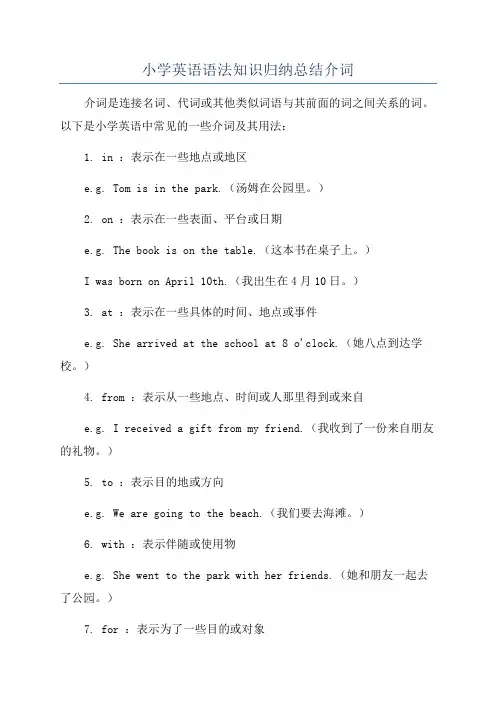
小学英语语法知识归纳总结介词介词是连接名词、代词或其他类似词语与其前面的词之间关系的词。
以下是小学英语中常见的一些介词及其用法:1. in :表示在一些地点或地区e.g. Tom is in the park.(汤姆在公园里。
)2. on :表示在一些表面、平台或日期e.g. The book is on the table.(这本书在桌子上。
)I was born on April 10th.(我出生在4月10日。
)3. at :表示在一些具体的时间、地点或事件e.g. She arrived at the school at 8 o'clock.(她八点到达学校。
)4. from :表示从一些地点、时间或人那里得到或来自e.g. I received a gift from my friend.(我收到了一份来自朋友的礼物。
)5. to :表示目的地或方向e.g. We are going to the beach.(我们要去海滩。
)6. with :表示伴随或使用物e.g. She went to the park with her friends.(她和朋友一起去了公园。
)7. for :表示为了一些目的或对象e.g. I bought a cake for my mom's birthday.(我为我妈妈的生日买了一个蛋糕。
)8. by :表示通过其中一种方式或交通工具e.g. I go to school by bus every day.(我每天坐公交车去学校。
)9. about :表示关于一些话题或主题e.g. We had a discussion about our summer vacation plans.(我们就暑假计划进行了一次讨论。
)10. to :表示直接的动作对象或方向e.g. I gave the present to my best friend.(我把礼物给了我最好的朋友。
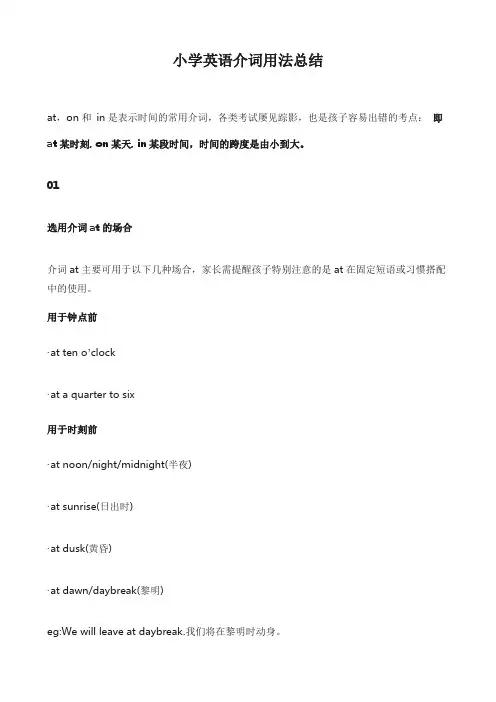
小学英语介词用法总结at,on和in是表示时间的常用介词,各类考试屡见踪影,也是孩子容易出错的考点:即at某时刻, on某天, in某段时间,时间的跨度是由小到大。
01选用介词at的场合介词at主要可用于以下几种场合,家长需提醒孩子特别注意的是at在固定短语或习惯搭配中的使用。
用于钟点前·at ten o’clock·at a quarter to six用于时刻前·at noon/night/midnight(半夜)·at sunrise(日出时)·at dusk(黄昏)·at dawn/daybreak(黎明)eg:We will leave at daybreak.我们将在黎明时动身。
用于表示进餐时间。
如:·at breakfast/lunch/supper(在早餐时/午餐时/晚餐时) eg:He drinks tea at breakfast.他在早餐时饮茶。
用于表示年龄时。
如:·at 14(= at the age of14在14岁)eg: He left home at the age of 16.他十六岁离开了家。
用于一些固定短语或习惯搭配中。
如:·at Christmas·at New Year·at Thanksgiving (感恩节)·at the beginning/end of last month·at the moment/ at that time·at this time of day·at a bad time of year·at first (起初)·at last (终于)02选用介词on的场合用于星期、日期(包括该天的各部分)前·on Sundays/weekdays·on Monday morning / afternoon / eveningeg:I'm flying home on Sunday afternoon. 我星期四下午乘飞机回家。

小学英语常用介词2)after(在……之后):after breakfast 早饭后,after school 放学后,after class 课后3)before(在……之前):before class 课前,before lunch 午饭前4)at(在):at home在家,at school 在学校,at work 在工作。
5)in(在……里面;用;戴):in English 用英语,in a hat 戴帽子,in front of 在……前面,in line 排成一行,in the end 最后,in the open air 在野外,in a minute立刻,in surprise 惊奇地,in time及时,in trouble 处在困难中。
6)on(在、关于):on one’s way home 回家路上,on duty 值日,on foot 步行,on top of 在……上面。
on the earth 在地球上。
7)under(在……下面):under the desk 在书桌下,under the tree 在树下8)between(在两者之间):between the two children 在两个孩子之间,between A and B 在A 和B之间。
9)beside(在……旁边):sit beside her 坐在她身边,beside the river 在河边。
10)behind(在……后面):behind the house 在房子后面,behind the door 在门后。
11)near(在……附近):near the river 在河边,stand near the door 站在门旁。
12)into(在……里):come into the classroom 进入教室,fall into the water 掉进水里13)outside (在……之外):outside of gate 在大门外。
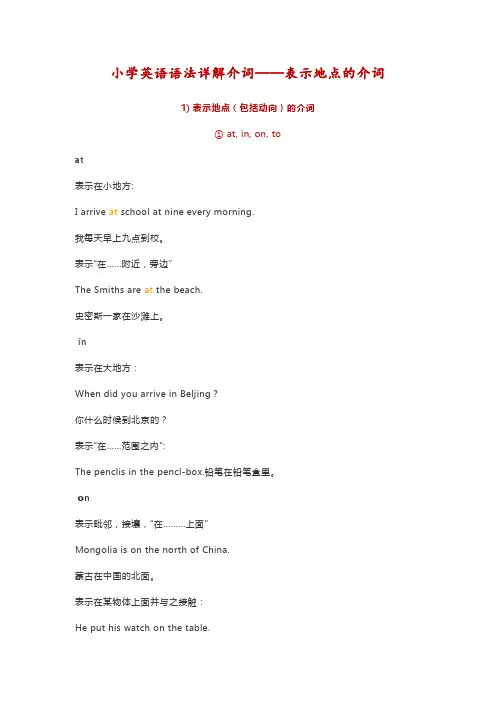
小学英语语法详解介词——表示地点的介词1) 表示地点(包括动向)的介词① at, in, on, toat表示在小地方:I arrive at school at nine every morning.我每天早上九点到校。
表示“在……附近,旁边”The Smiths are at the beach.史密斯一家在沙滩上。
in表示在大地方:When did you arrive in Beljing?你什么时候到北京的?表示“在……范围之内”:The penclis in the pencl-box.铅笔在铅笔盒里。
on表示毗邻,接壤,“在………上面”Mongolia is on the north of China.蒙古在中国的北面。
表示在某物体上面并与之接触:He put his watch on the table.他把手表放桌上。
to表示“在……范围外”不强调是否接壤:或“到……”:Japan is to the east of China.日本在中国的东面。
②above, overabove指“在……上方”,不强调是否垂直,与below相对:The bird is flying above my head.鸟儿在我头顶上飞过。
over指垂直的上方,与under相对,over有覆盖的含义在里面:There is a bridge over the river.江上有座桥。
③below, underunder表示“在……正下方”:There is a cat under the table.桌子下面有只猫。
below表示“在……下方”,不一定在正下方:Please write your name below the line.请在线的下方写上您的名字。
④in front of, in the front ofin front of“在……前面”,指甲物在乙物之前,两者互不包括:其反义词是behind (在……的后面):There are some flowers in front of the house.房子前面有些花卉。

介词的用法1 .表示地点位置的介词1)at ,in, on, to, forat⑴表示在小地方;(2)表示“在……附近,旁边”in⑴表示在大地方;(2)表示“在.一范围之内”。
on表示毗邻,接壤,“在……上面”。
to表示在……范围外,不强调是否接壤;或“到……”2)above, over, on 在……上above指在……上方,不强调是否垂直,与below相对;over指垂直的上方,与under相对,但over与物体有一定的空间,不直接接触。
on表示某物体上面并与之接触。
The bird is flying above my head. There is a bridge over the river.He put his watch on the desk.3)below, under 在... 下面under表示在…正下方below表示在……下,不一定在正下方There is a cat under the table.Please write your name below the line.4)in front [frant]of, in the front of 在..... 前面in front of…意思是“在……前面”,指甲物在乙物之前,两者互不包括;其反义词是behind (在.. 的后面)。
There are some flowers in front of the house.(房子前面有些花卉。
)in the front of意思是"在…..的前部”,即甲物在乙物的内部.反义词是at the back of…(在……范围内的后部)。
There is a blackboard in the front of our classroom.我们的教室前边有一块黑板。
Our teacher stands in the front of the classroom.我们的老师站在教室前.(老师在教室里)5)beside,behindbeside表示在... 旁边behind表示在... 后面2 .表示时间的介词1)in , on,at 在... 时in表示较长时间,如世纪、朝代、时代、年、季节、月及一般(非特指)的早、中、晚等。
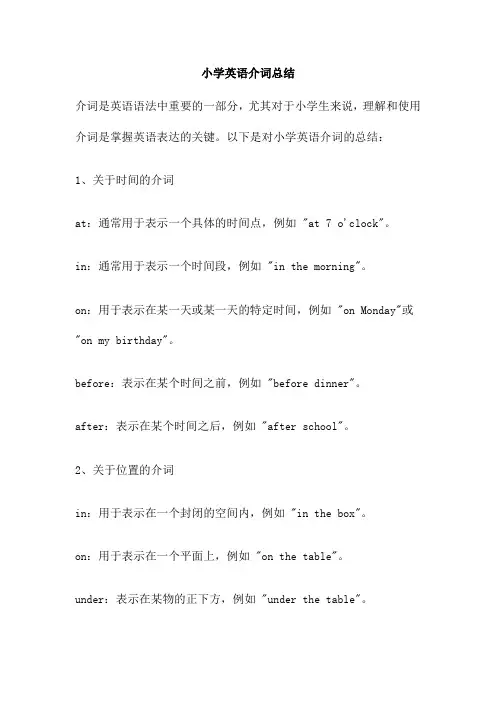
小学英语介词总结介词是英语语法中重要的一部分,尤其对于小学生来说,理解和使用介词是掌握英语表达的关键。
以下是对小学英语介词的总结:1、关于时间的介词at:通常用于表示一个具体的时间点,例如 "at 7 o'clock"。
in:通常用于表示一个时间段,例如 "in the morning"。
on:用于表示在某一天或某一天的特定时间,例如 "on Monday"或"on my birthday"。
before:表示在某个时间之前,例如 "before dinner"。
after:表示在某个时间之后,例如 "after school"。
2、关于位置的介词in:用于表示在一个封闭的空间内,例如 "in the box"。
on:用于表示在一个平面上,例如 "on the table"。
under:表示在某物的正下方,例如 "under the table"。
above:表示在某物的上方,但是不一定是正上方,例如 "above the table"。
beside:表示在某物的旁边,例如 "beside the book"。
3、关于方向的介词to:用于表示朝向某个方向或地点,例如 "go to school"。
from:用于表示从一个地方或位置到另一个地方或位置,例如 "come from school"。
towards:表示朝向某个方向或地点,但是不一定到达那里,例如"walk towards the park"。
4、关于原因的介词because:用于表示原因或理由,例如 "I am late because I missed the bus"。
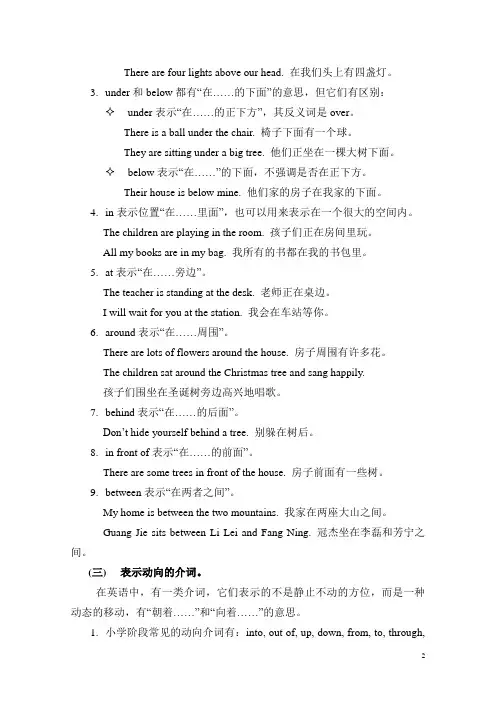
常见介词及用法(一)表示时间的介词1.英语里最常见的时间介词有:at, in, on, before, after和from。
2.at , in和on这三个词都表示时间。
✧at主要指具体的钟点:at half past eight 在八点半✧in一般指某一段时间:in January 在一月份✧on指具体在某一天:on Monday 在星期一3.before和after表示时间的先后顺序。
✧before表示“在……之前”。
You should wash your hands before eating. 吃饭前你应该洗手。
✧after表示“在……之后”。
They often play basketball after dinner. 他们放学后经常打篮球。
4.from作时间介词含有“从……开始”的意思,常和to连用,组成“from…to…”的结构,表示“从……到……”的意思。
We go to school from Monday to Friday. 我们从周一到周五上学。
(二)表示方位的介词,也就是表示位置和地点的介词。
1.小学阶段常见的方位介词有:on, in, at, under, over, above, below, about,around, between等。
2.on, over和above这三个词都有“在……上面”的意思,但它们所表示的方位还是有些不同。
✧on表示两个物体的表面相互接触。
如:There is a book on the desk. 桌上有一本书。
The boy is sleeping on the desk. 那个孩子睡在地上。
✧over表示“在……的正上方”,两个物体表面没有接触。
如:There is a light bulb over my head. 在我头顶上有一个灯泡。
✧above表示两个物体中一个在另一个的上方,如:The plane is flying above the clouds. 飞机上云层上飞行。
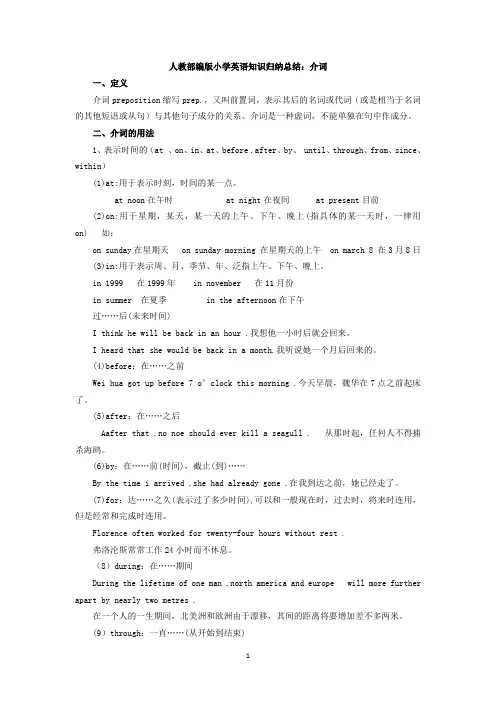
人教部编版小学英语知识归纳总结:介词一、定义介词preposition缩写prep.,又叫前置词,表示其后的名词或代词(或是相当于名词的其他短语或从句)与其他句子成分的关系。
介词是一种虚词,不能单独在句中作成分。
二、介词的用法1、表示时间的(at 、on、in、at、before ,after、by、 until、through、from、since、within)(1)at:用于表示时刻,时间的某一点。
at noon在午时 at night在夜间 at present目前(2)on:用于星期,某天,某一天的上午、下午、晚上(指具体的某一天时,一律用on) 如:on sunday在星期天 on sunday morning 在星期天的上午on march 8 在3月8日(3)in:用于表示周、月、季节、年、泛指上午、下午、晚上。
in 1999 在1999年 in november 在11月份in summer 在夏季 in the afternoon在下午过……后(未来时间)I think he will be back in an hour .我想他一小时后就会回来。
I heard that she would be back in a month.我听说她一个月后回来的。
(4)before:在……之前Wei hua got up before 7 o’clock this morning .今天早晨,魏华在7点之前起床了。
(5)after:在……之后Aafter that ,no noe should ever kill a seagull . 从那时起,任何人不得捕杀海鸥。
(6)by:在……前(时间),截止(到)……By the time i arrived ,she had already gone .在我到达之前,她已经走了。
(7)for:达……之久(表示过了多少时间),可以和一般现在时,过去时,将来时连用,但是经常和完成时连用。
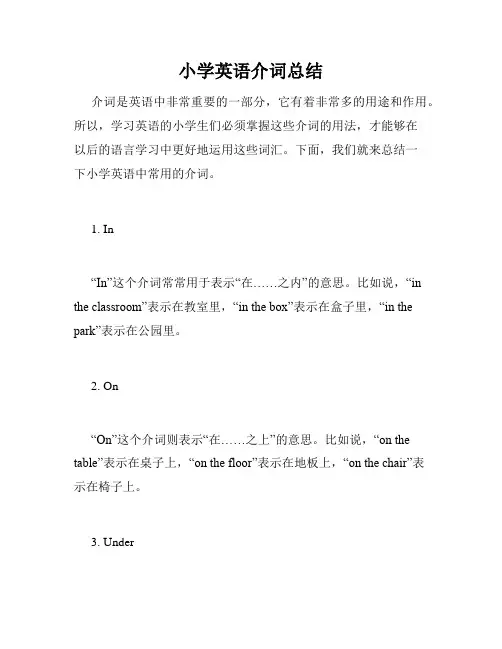
小学英语介词总结介词是英语中非常重要的一部分,它有着非常多的用途和作用。
所以,学习英语的小学生们必须掌握这些介词的用法,才能够在以后的语言学习中更好地运用这些词汇。
下面,我们就来总结一下小学英语中常用的介词。
1. In“In”这个介词常常用于表示“在……之内”的意思。
比如说,“in the classroom”表示在教室里,“in the box”表示在盒子里,“in the park”表示在公园里。
2. On“On”这个介词则表示“在……之上”的意思。
比如说,“on the table”表示在桌子上,“on the floor”表示在地板上,“on the chair”表示在椅子上。
3. Under“Under”这个介词则是表示“在……下面”的意思。
比如说,“under the bed”表示在床底下,“under the tree”表示在树下,“under the desk”表示在桌子下面。
4. Beside“Beside”这个介词则是表示“在……旁边”的意思。
比如说,“beside the window”表示在窗户旁边,“beside the door”表示在门旁边,“beside the road”表示在路边。
5. Behind“Behind”这个介词则表示“在……后面”的意思。
比如说,“behind the building”表示在建筑物后面,“behind the chair”表示在椅子后面,“behind the tree”表示在树后面。
6. Above“Above”这个介词则表示“在……上面”的意思。
比如说,“above the clouds”表示在云层之上,“above the sky”表示在天空之上,“above the mountain”表示在山顶之上。
7. Below“Below”这个介词则表示“在……下面”的意思。
比如说,“below the sea”表示在海底,“below the ground”表示在地底,“below the surface”表示在表面之下。

小学英介介( Preposition )一、概括介是英中很活的,一般置于名以前。
它常和名或名性组成介短。
同一个介常和不一样的搭配形成固定搭配,表示不一样意。
二、常用介的基本用法at①表示:I go to school at seven every day我每日清晨7 点去上学。
②表示在某一详细地址:He is standing at the bus stop他站在公共汽站。
③表示作的方向、目:Let me have a look at the picture我看看幅。
④用于某些固定搭配:at once 马上、上at last 最后at the same time同at first开始not at all一点也不about①表示大:I's about six o'clock now.在大 6 点了。
②表示地址;在⋯⋯周:Everthing about me is so beautiful我周的全部都那么美好。
③对于,于:We are talking about the news.我正在新。
after①在⋯⋯以后:After dinner I watch TV.晚后我看。
②在⋯⋯后边:He came into the room after me.他在我后边了房。
behind①在⋯⋯以后:There is a bike behind the tree.后有一自行②比⋯⋯晚,于:The train is behind time.火晚点了by①在⋯⋯旁:He is sitting by the bed.他正坐在床。
②到⋯⋯ 候:We have learned three English songs by now.到在止,我已学会了三首英文歌曲。
③以⋯⋯方式:I go to school by bus.④用于某些固定搭配:one by one 我乘公共汽去上学。
一个接一个by the way便一句for① ,,替:I'll make a card for my teacher.我要老做卡片。
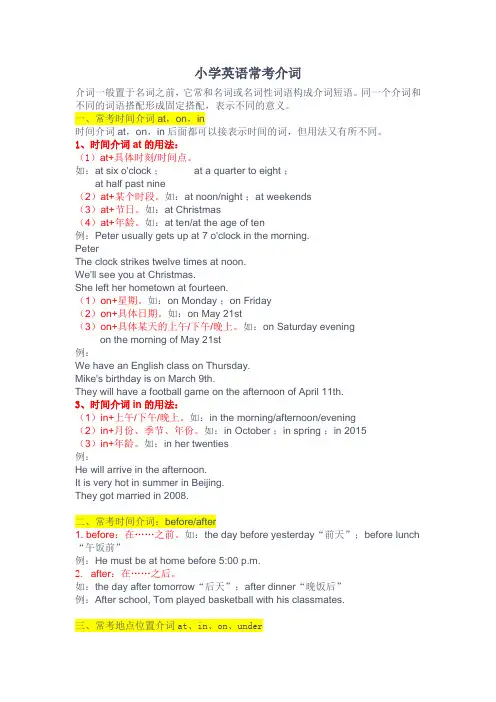
小学英语常考介词介词一般置于名词之前,它常和名词或名词性词语构成介词短语。
同一个介词和不同的词语搭配形成固定搭配,表示不同的意义。
一、常考时间介词at,on,in时间介词at,on,in后面都可以接表示时间的词,但用法又有所不同。
1、时间介词at的用法:(1)at+具体时刻/时间点。
如:at six o'clock ;at a quarter to eight ;at half past nine(2)at+某个时段。
如:at noon/night ;at weekends(3)at+节日。
如:at Christmas(4)at+年龄。
如:at ten/at the age of ten例:Peter usually gets up at 7 o'clock in the morning.PeterThe clock strikes twelve times at noon.We'll see you at Christmas.She left her hometown at fourteen.(1)on+星期。
如:on Monday ;on Friday(2)on+具体日期。
如:on May 21st(3)on+具体某天的上午/下午/晚上。
如:on Saturday evening on the morning of May 21st例:We have an English class on Thursday.Mike's birthday is on March 9th.They will have a football game on the afternoon of April 11th.3、时间介词in的用法:(1)in+上午/下午/晚上。
如:in the morning/afternoon/evening(2)in+月份、季节、年份。
如:in October ;in spring ;in 2015(3)in+年龄。
英语中的介词早、午、晚要用in,at黎明、午夜、点与分。
年、月、年月、季节、周,阳光、灯、影、衣、冒in。
将来时态in...以后,小处at大处in。
有形with无形by,语言、单位、材料in。
特征、方面与方式,心情成语惯用in。
介词at和to表方向,攻击、位置、恶、善分。
日子、日期、年月日,星期加上早、午、晚,收音、农场、值日on,关于、基础、靠、著论。
着、罢、出售、偷、公、假,故意、支付、相反,准。
特定时日和“一……就”,on后常接动名词。
年、月、日加早、午、晚,of之前on代in。
步行、驴、马、玩笑on,cab,carriage则用in。
at山脚、门口、在当前,速、温、日落、价、核心。
工具、和、同随with,具有、独立、就、原因。
就……来说宾译主,对、有、方状、表细分。
海、陆、空、车、偶、被by,单数、人类know to man。
this、that、tomorrow,yesterday,next、last、one。
接年、月、季、星期、周,介词省略已习惯。
over、under正上下,above、below则不然,若与数量词连用,混合使用亦无关。
’beyond超出、无、不能,against靠着,对与反。
besides,except分内外,among之内along沿。
同类比较except,加for异类记心间。
原状because of,、owing to、due to表语形容词under后接修、建中,of、from物、化分。
before、after表一点,ago、later表一段。
before能接完成时,ago过去极有限。
since以来during间,since时态多变换。
与之相比beside,除了last but one。
复不定for、找、价、原,对、给、段、去、为、作、赞。
快到、对、向towards,工、学、军、城、北、上、南。
but for否定用虚拟,复合介词待后言。
ing型由于鉴,除了除外与包合。
小学英语知识归纳总结:介词一、定义介词preposition缩写prep.,又叫前置词,表示其后的名词或代词(或是相当于名词的其他短语或从句)与其他句子成分的关系。
介词是一种虚词,不能单独在句中作成分。
二、介词的用法1、表示时间的(at 、on、in、at、before ,after、by、until、through、from、since、within)(1)at:用于表示时刻,时间的某一点。
at noon在午时at night在夜间at present目前(2)on:用于星期,某天,某一天的上午、下午、晚上(指具体的某一天时,一律用on) 如:on sunday在星期天on sunday morning 在星期天的上午 on march 8 在3月8日(3)in:用于表示周、月、季节、年、泛指上午、下午、晚上。
in 1999 在1999年in november 在11月份in summer 在夏季in the afternoon在下午过……后(未来时间)I think he will be back in an hour .我想他一小时后就会回来。
I heard that she would be back in a month.我听说她一个月后回来的。
(4)before:在……之前Wei hua got up before 7 o’clock this morning .今天早晨,魏华在7点之前起床了。
(5)after:在……之后Aafter that ,no noe should ever kill a seagull . 从那时起,任何人不得捕杀海鸥。
(6)by:在……前(时间),截止(到)……By the time i arrived ,she had already gone .在我到达之前,她已经走了。
(7)for:达……之久(表示过了多少时间),可以和一般现在时,过去时,将来时连用,但是经常和完成时连用。
小学英语三至五年级介词表什么是介词介词是连接词,常用来连接名词和名词、名词和动词、名词和形容词等,表示时间、地点、方式、原因、目的等。
常见介词- at 在……的时候或地点,例如:at home(在家里)、at school(在学校)、at night(在晚上)at在……的时候或地点,例如:at home(在家里)、at school(在学校)、at night(在晚上)- in 表示在……之内,例如:in the box(在盒子里)、in the room(在房间里)、in the morning(在早上)in表示在……之内,例如:in the box(在盒子里)、in the room(在房间里)、in the morning(在早上)- on 表示在……之上,例如:on the table(在桌子上)、on the bed(在床上)、on Sunday(在星期天)on表示在……之上,例如:on the table(在桌子上)、on the bed(在床上)、on Sunday(在星期天)- to 表示方向和目的地,例如:go to school(去学校)、give something to someone(把东西给某人)to表示方向和目的地,例如:go to school(去学校)、give something to someone(把东西给某人)- with 表示伴随,例如:play with friends(和朋友一起玩)、walk with a dog(和一只狗一起散步)with表示伴随,例如:play with friends(和朋友一起玩)、walk with a dog(和一只狗一起散步)- without 表示没有,例如:go without me(没有带我去)、eat without vegetables(没有吃蔬菜)without表示没有,例如:go without me(没有带我去)、eat without vegetables(没有吃蔬菜)- for 表示目的,例如:buy a gift for my mom(为我妈妈买礼物)for表示目的,例如:buy a gift for my mom(为我妈妈买礼物)- of 表示从属,例如:a picture of my family(一幅我家庭的照片)、the color of the sky(天空的颜色)of表示从属,例如:a picture of my family(一幅我家庭的照片)、the color of the sky(天空的颜色)希望这份介词表能够帮助到小学三至五年级的同学们。
小学英语介词用法1、小学英语介词at,in与on在时间方面的用法at表示时间的一点;in表示一个时期;on表示特殊日子;如:He goes to school at seven o’clock in the morning. 他早晨七点上学;Can you finish the work in two days. 你能在两天内完成这个工作吗Linda was born on the second of May. 琳达五月二日出生;1. at后常接几点几分,天明,中午,日出,日落,开始等;如:at five o’clock 五点,at down 黎明,at daybreak 天亮,at sunrise 日出,at noon 中午,at sunset 日落,at midnight 半夜,at the beginning of the month 月初, at that time 那时,at that moment 那会儿,at this time of day 在一天的这个时候;2. in后常接年,月,日期,上午,下午,晚上,白天,季节,世纪等;如:in 20062006年,in May,2004 2004年五月,in the morning 早晨/上午,in the afternoon 下午,in the evening 晚上,in the night 夜晚,in the daytime 白天,in the 21st century 21世纪,in three days weeks/month三天周/个月,in a week 一周,in spring 春季;3. on后常接某日,星期几,某日或某周日的朝夕,节日,及有修饰语修饰的下午、晚上等;如:on Sunday 星期日,on a warm morning in April 四月的一个温暖的上午,on a December night 12月的一个夜晚,on that afternoon 那天下午,on the following night 下一个晚上,on Christmas afternoon 圣诞节下午,on October 1,1949 1949年10月1日,on New Year’s Day 新年,on New Year’s Eve 除夕,on the morning of the 15th 15日的早上等;小学英语语法介词for 的用法小结1. 表示"当作、作为";如:I like some bread and milk for breakfast. 我喜欢把面包和牛奶作为早餐;What will we have for supper 我们晚餐吃什么2. 表示理由或原因,意为"因为、由于";如:Thank you for helping me with my English. 谢谢你帮我学习英语;Thank you for your last letter. 谢谢你上次的来信;Thank you for teaching us so well. 感谢你如此尽心地教我们;3. 表示动作的对象或接受者,意为"给……"、"对…… 而言";如:Let me pick it up for you. 让我为你捡起来;Watching TV too much is bad for your health. 看电视太多有害于你的健康;4. 表示时间、距离,意为"计、达";如:I usually do the running for an hour in the morning. 我早晨通常跑步一小时; We will stay there for two days. 我们将在那里逗留两天;5. 表示去向、目的,意为"向、往、取、买"等;如:Let's go for a walk. 我们出去散步吧;I came here for my schoolbag.我来这儿取书包;I paid twenty yuan for the dictionary. 我花了20元买这本词典;6. 表示所属关系或用途,意为"为、适于……的";如:It's time for school. 到上学的时间了;Here is a letter for you. 这儿有你的一封信;7. 表示"支持、赞成";如:Are you for this plan or against it 你是支持还是反对这个计划8. 用于一些固定搭配中;如:Who are you waiting for你在等谁For example,Mr Green is a kind teacher. 比如,格林先生是一位心地善良的老师;小升初介词语法讲解地点介词in, at, on above, below, over, under, among, between的用法及区别1in, at与on的用法及区别①in表示地点,意为“在…内”,用于内部;如:There isn’t a cloud in the sky. 天空中没有一片云;He put his hands in his pockets. 他把手放入口袋;Wh at’s in the box 盒子里有什么②on意为“在…上面”,用于表面接触,指在一个平面上;如:What’s on the table 桌子上有什么There was a carpet on the floor. 地板上铺着一块地毯;③表示“在某地”时,at后面接小地方,in后接大地方;如:at home在家 at the bus stop在汽车站 in China在中国 in the world 在世界上2above与below的用法及区别above的意思是“在…之上”“高于…”,表示相对高度,不一定是在正上方,它的反义词是below;如:The plane flew above the clouds. 飞机在云层上面飞行;The Dead Sea is below sea level. 死海的海面低于海平面;3over与under的用法及区别over的意思是“在…之上”,表示垂直之上,其反义词是under;如:There is a bridge over the river. 河上有座桥;There is a boat under the bridge. 桥下有只船;4among与between的用法及区别between一般指“两者之间”;among用于三个或三个以上的人或物之间,或笼统的一群人或一些物之中;如:The house stands between two farms. 这座房子位于两个农场之间;The house stands among farms. 这座房子位于农场之间;5beside与near的用法及区别本部分只出现在教师版中①beside表示“近旁”“紧靠”,相当于next to;如:Come and sit beside me. 来坐在我的身旁;②near意为“在…附近”,可以表示空间、时间关系等;如:He sits near the window. 他坐在窗户附近;6in front of与in the front of的用法及区别本部分只出现在教师版中in front of表示“在…之前”;表示在某一空间外部的前面,in the front of 表示在某一空间内部的前面;如:There are some trees in front of the classroom. 教室前有一些树;Don’t sit in the f ront of the car. 不要坐在小汽车的前部;3方式介词like像… with用… in用… by用…方式介词:with, by, in的用法及区别with, by, in表示工具、手段和材料时,with多指用工具,用身体的某一部位或器官;by表示使用的方法、手段;in指使用某种语言、工具的具体类型等;如:You can see it with your own eyes. 你可以亲自去看看;Why don’t we go there by car instead 我们为什么不坐小汽车去呢She can speak it in English. 她能用英语说;4其他含义的介词of具有…的性质 with带有… without没有… instead of而不是… except 除了…beside包括…在内1.表示地点位置的介词in, on, to,forat 1表示在小地方; 2表示“在……附近,旁边”in 1表示在大地方; 2表示“在…范围之内”;on 表示在……上面”;to 表示或“到……”under 在……下面in the front of在……前面behind在……的后面;There are some flowers in front of the house.房子前面有些花卉;beside 表示在……旁边behind 表示在……后面2.表示时间的介词1in , on,at 在……时in表示较长时间,如世纪、朝代、时代、年、季节、月及一般非特指的早、中、晚等;如in the 20th century, in the 1950s, in 1989, in summer, in January, in the morning, in one’s life , in one’s thirties等;on表示具体某一天及其早、中、晚;如on May 1st, on Monday, on New Year’s Day, on a cold night in January, on a fine morning, on Sunday afternoon等;at表示某一时刻或较短暂的时间,或泛指圣诞节,复活节等;如at 3:20, at this time of year, at the beginning of, at the end of …, at the age of …, at Christmas, at night, at noon, at this moment等;注意:在last, next, this, that, some, every 等词之前一律不用介词;如:We meet every day.2from 自从……3after, behind 在……之后after主要用于表示时间;behind主要用于表示位置;时间名词前介词用法口诀年前周前要用in具体日子却要禁遇到几号要用on上午下午又是in要说某日上下午用on换in记清楚午夜黄昏用at黎明用它也不错at用在时分前说“差”可要用上to说"过''要用past.表示“在……之间”的介词:关于2by, with, in 表示方法、手段、工具by 以……方法、手段或泛指某种交通工具;with 表示用…工具、手段,一般接具体的工具和手段;in 表示用…方式,用…语言语调、笔墨、颜色等;小学英语介词总结介词Preposition一、概述介词是英语中很活跃的词,一般置于名词之前;它常和名词或名词性词语构成介词短语;同一个介词常和不同的词语搭配形成固定搭配,表示不同意义;二、常用介词的基本用法at①表示时间:I go to school at seven every day 我每天早上7点去上学;②表示在某一具体地点:He is standing at the bus stop 他站在公共汽车站;③表示动作的方向、目标:Let me have a look at the picture 让我看看这幅图;④用于某些固定搭配:at once 立刻、马上at last 最后at the same time 同时at first 开始时not at all 一点也不about①表示大约时间:I's about six o'clock now. 现在大约6点钟了;②表示地点;在……周围:Everthing about me is so beautiful 我周围的一切都那么美好;③关于,对于:We are talking about the news. 我们正在谈论新闻;after①在……之后:After dinner I watch TV. 晚饭后我看电视;②在……后面:He came into the room after me. 他在我后面进了房间;behind①在……之后:There is a bike behind the tree. 树后有一辆自行车②比……晚,迟于:The train is behind time. 火车晚点了by①在……旁:He is sitting by the bed. 他正坐在床边;②到……时候:We have learned three English songs by now. 到现在为止,我们已经学会了三首英文歌曲;③以……方式:I go to school by bus. 我乘公共汽车去上学;④用于某些固定搭配:one by one 一个接一个by the way 顺便说一句for①为,给,替:I'll make a card for my teacher. 我要给老师做张卡片;②由于:Thank you for helping me. 谢谢你帮我;③表示给某人用的:There is letter for you. 这儿有你一封信;in①在……里面:The pencil is in the desk. 铅笔在课桌里;②在一段时间里:We have four classes in the morning. 我们上午有四节课;③用,以:What's this in English 这用英语怎么说④在某一年份,季节,月份:in 2002, in spring, in January⑤表示状态,服饰:Helen is in yellow. 海伦身穿黄色衣服;⑥在……方面:He is weak in English. 他的英语不行;⑦用于某些固定搭配:in front of 在……前面in the end 最后in time 及时like①像……样:He looks like his father. 他像他的父亲;②这样,那样:Don't look at me like that. 别那样看着我;③怎样:What's the weather like天气怎样;near靠近,在……附近:My bed is near the window. 我的床在窗户旁;of①的表示所属关系:This is a photo of my family. 这是一张我家的照片;②……的用于所有格:He is a friend of mine. 他是我的一个朋友;③表示数量与连词连用:One of us is from Beijing. 我们中有一个来自北京④想到,谈到:I often think of them. 我常常想到他们;⑤用于某些固定搭配:of course 当然because of 因为,由于on①在……上面:There are some apple on the tree. 树上有些苹果;②在星期天,在某天的上午下午,晚上:They go to English class on Sunday. 星期天他们去上英语课;I left Beijing on the morning of May 1. 我在5月1日早上离开北京;③用于某些固定搭配:on duty 值日on time 准时over①在……正上方:There is a lamp over the table. 桌子上方有一盏灯;②遍及,穿过:There is a bridge over the river. 有座桥横跨那条河;③超过,不止:She is a little over 2. 她两岁多了;to①到,往,向:He walks to the window. 他走向窗户;②表示时间、数量,到……为止Please count from ten to thirty. 请从10数到30.③向,对,给:Happy New Year to you all. 大家新年好;underWhat's under your desk 你书桌底下是什么with①和,写:Could you go home with me 你能和我一起回家吗②表示伴随状态,带有:Who's that girl with glasses 那位戴眼睛的女孩是谁三、介词的固定搭配1介词和名词的连用2动词和介词的连用at arrive at/in 到达at first 起初;开始get off 下车at last 最后help sb. With sth. 帮组某人做某事at school 在上课,在上学ask for 请求at the moment 此刻get up 起床at home 在家;无拘束laugh at 嘲笑at present 现在learn from 向……学习at work 上班,在工作look after 照顾at the same time 同时look for 寻找think for 想到on worry about 担心on duty 值日listen to 听on holiday 度假look at 看;注视on time 准时talk about 交谈;谈on the left/right 在左/右边wait for 等候;等on the radio 在广播中thank for 为……而感谢on foot 步行on sale 出售;降价出售3形容词和介词连用on TV 在电视上播放be afraid of 害怕on the phone 在电话中be careful with 小心;关心on the way 在路上be interested in 对……感兴趣be good at 善于in be proud of 感到自豪in all 总体be crazy about 酷爱in class 在课堂上be late for 干某事迟到in English 用英语be good for 对……有利in short 总之4其他in a hurry 匆忙地by+交通工具in the end 最后by bus/train/plane/air/ship/bike/sea/land…in bed 躺在床上lots of/a lot of 许多,大量in danger 在危险中at most 至多in fact 事实上at least 至少in time 及时地at once 立刻;马上in a minute 立刻 in order to 为了介词in at from about on by to for of with的用法⑴时间或地点介词in、on、at的用法区别:表示时间时, in表示在一段时间里在将来时句子中则表示在一段时间之后, on表示在具体的某一天或者某天的上下午等, at表示在某个时刻或者瞬间;表示地点时, in表示在某个范围之内, on表示在某个平面上或与一个面相接触,at则表示在某个具体的场所或地点;如:He was born on the morning of May 10th.他出生于五月十日的早晨/ I usually get up at 7:00 in the morning.我通常在早上的七点钟起床/ His glasses are right on his nose.他的眼镜就架在他的鼻子上/ He is at the cinema at the moment.此刻他正在电影院⑵after与in表示时间的用法区别:“after+具体时刻/从句”表示“在…时刻之后”常用于一般时态;“in+一段时间”表示“在多久之后”,常用于将来时态;如:He said that he would be here after 6:00.他说他六点钟之后会来这儿/ My father is coming back from England in about a month.我父亲大约一个月以后从英国回来⑶since与for表示时间的用法区别:“since+具体时刻/that-从句”表示“自从…起一直到现在”,“for +一段斶间”表示“总共有…之久”,都常用于完成时态;如:Uncle Li has worked in this factory since 1970.李叔叔自从1970年起就在这家工厂工作了/ Uncle Li has worked in this factory for over 30 years. 李叔叔在这家工厂已经工作了30多年⑷by、in与with表示方式的用法区别:都可以表示“工具、手段”,但是by主要表示“乘坐”某个交通工具或“以……方式”,在被动句中可以表示动作的执行者;in表示“使用”某种语言/文字,with表示“使用”某个具体的工具、手段;如:We see with our eyes and walk with our feet.我们用眼睛看东西,用双脚走路/ Please write that article文章in English.请你用英语写那篇文章/ Let’s go to the zoo by taxi.我们打的去动物园吧;/ It was written by Lao She.那是老舍写的⑸about与on的用法区别:都可以表示“有关…”,但是about的意义比较广,而on主要表示“有关…专题/课程”;如:Tom is going to give a talk on the history of America.汤姆要作一个美国历史的报告/ They are very excited talking about the coming field trip.他们兴致勃勃地谈论着即将来到的野外旅游⑹through与across、over的用法区别:through指“穿过…门洞/人群/树林”;across 和over可以指“跨越…街道/河流”,可互换,但是表示“翻过…”时只能用over. 如:Just thena rat 鼠ran across the road.就在那时一只老鼠跑过路面/ There is a bridgeacross/over the river.河上有座桥/ They climbed over the mountain and arrived there ahead of time.他们翻过大山提前到达了那里/ The visitors went through a big gate into another park.参观者们穿过一个大门来到另一个公园7as与like的区别:两个词都表示“像……”,但是as译为“作为……”,表示的是职业、职务、作用等事实,而like译为“像……一样”,表示外表,不是事实;如:Let me speak to you as a father.我以父亲的身份和你讲话;说话者是听者的父亲/ Let me speak to you like a father.让我像一位父亲一样和你讲话说话者不是听者的父亲8at the end of、by the end of、to the end、in the end的用法区别:at the end of…既可以表示时间也可以表示地点,译为“在…末;在…尽头”,常与过去时连用;by the end of…只能表示时间,译为“在…前;到…为止”,常用于过去完成时;in the end与at last基本等义,表示“终于、最后”,通常用于过去时;to the end译为“到…的终点为止”,前面往往有表示运动或连续性的动词;如:By the end of last term we had learned 16 units of Book III.到上学期期末我们已经学习了第三册16个单元/ At the end of the road you can find a big white house with brown windows.在路的尽头你能找到一幢有棕色窗户的白房子/ They left for Beijing at the end of last week.上周末他们动身去了北京/ In the end he succeeded in the final exams.他最终在期末考试中考及格了/ We should go on with the work to the end.我们应该把工作干到底/ Follow this road to the end and you will see a post office.沿这条路走到底就能看见一家邮电局9for a moment、for the moment、in a moment、at the moment的区别:for a moment“一会儿、片刻”=for a while,常与持续性动词连用;for the moment“暂时、目前”,常用于现在时;in a moment“一会儿、立即、马上”=soon; in a few minutes,一般用于将来时;at the moment“此刻,眼下”=now,用于现在进行时;如:Please wait for a moment.请稍等/ Let’s leave things as they are for the moment.暂时就维持现状吧/ I’ll come back in a moment.我过会儿回来/ I am very busy at the moment.眼下我很忙10but的问题:用介词but引出另一个动词时,要注意:如果前面有do,后面就用原形动词,前面没有do时,后面的动词要加to;如:I could do nothing but wait.我什么也做不了只能等/ They had no choice选择but to fight.他们没有选择只有战斗11in front of 与in the front of:in front of“在…的前面”, 与in the front of“在…的前部”;如:A car was parking in front of the hall.大厅跟前停着一辆汽车/ In the front of the hall stood a big desk.大厅前部立着一个大讲台12except for与besides的区别:except“除了”,表示排除掉某人物,即不包含;而besides“除了”则表示包含,即“不仅……又……”;如:Everyone went to the Palace Museum except Tom.除了Tom,大家都去了故宫博物院Tom没有去故宫/ Besides Chinese he also studied many other subjects.除了汉语之外,他还学其他许多功课“汉语”也是他学的功课之一other than 除了......之外...... There 're nobody here other than me 与.....不同..... 与.....不同方式.....we can't get there other than by swimming.Apart from : with the exception of ...; besides... Apart form a few scratches, the car was undamagedtalk _______ a long are they talking__________ computers games too long is really bad ______your eyes. 't stand too near __________ the tiger cage,it's dangerous. moon looks ___________ a plate in the sky.should try to do everything ___________ ourselves.。
小学英语介词总结小学英语介词总结介词(Preposition )一、一、 概述概述介词是英语中很活跃的词,介词是英语中很活跃的词,一般置于名词之前。
一般置于名词之前。
它常和名词或名词性词语构成介词短语。
它常和名词或名词性词语构成介词短语。
同同一个介词常和不同的词语搭配形成固定搭配,表示不同意义。
一个介词常和不同的词语搭配形成固定搭配,表示不同意义。
二、二、 常用介词的基本用法常用介词的基本用法at ①表示时间:①表示时间: I go to school at seven every day 我每天早上7点去上学。
点去上学。
②表示在某一具体地点:②表示在某一具体地点: He is standing at the bus stop 他站在公共汽车站。
他站在公共汽车站。
③表示动作的方向、目标:③表示动作的方向、目标: Let me have a look at the picture 让我看看这幅图。
让我看看这幅图。
④用于某些固定搭配:④用于某些固定搭配: at once 立刻、马上立刻、马上 at last 最后最后at the same time 同时同时 at first 开始时开始时not at all 一点也不一点也不一点也不about ①表示大约时间:①表示大约时间: I's about six o'clock now. 现在大约6点钟了。
点钟了。
②表示地点;在……周围:周围: Everthing about me is so beautiful 我周围的一切都那么美好。
③关于,对于:③关于,对于: We are talking about the news. 我们正在谈论新闻。
我们正在谈论新闻。
after ①在……之后:之后: After dinner I watch TV. 晚饭后我看电视。
晚饭后我看电视。
②在……后面:后面: He came into the room after me. 他在我后面进了房间。
小学英语介词总结
介词(Preposition)
一、概述
介词是英语中很活跃的词,一般置于名词之前。
它常和名词或名词性词语构成介词短语。
同一个介词常和不同的词语搭配形成固定搭配,表示不同意义。
二、常用介词的基本用法
At
①表示时间:I go to school at seven every day 我每天早上7点去上学。
②表示在某一具体地点:He is standing at the bus stop 他站在公共汽车站。
③表示动作的方向、目标:Let me have a look at the picture 让我看看这幅图。
④用于某些固定搭配:at once 立刻、马上at last 最后
at the same time 同时at first 开始时
not at all 一点也不
About
①表示大约时间:It's about six o'clock now. 现在大约6点钟了。
②表示地点;在……周围:Everything about me is so beautiful 我周围的一切都那么美好。
③关于,对于:We are talking about the news. 我们正在谈论新闻。
After
①在……之后:After dinner I watch TV. 晚饭后我看电视。
②在……后面:He came into the room after me. 他在我后面进了房间。
Behind
①在……之后:There is a bike behind the tree. 树后有一辆自行车
②比……晚,迟于:The train is behind time. 火车晚点了
By
①在……旁:He is sitting by the bed. 他正坐在床边。
②到……时候:We have learned three English songs by now. 到现在为止,我们已经学会了三首英文歌曲。
③以……方式:I go to school by bus. 我乘公共汽车去上学。
④用于某些固定搭配:one by one 一个接一个by the way 顺便说一句
For
①为,给,替:I'll make a card for my teacher. 我要给老师做张卡片。
②由于:Thank you for helping me. 谢谢你帮我。
③表示给(某人)用的:There is letter for you. 这儿有你一封信。
in
①在……里面:The pencil is in the desk. 铅笔在课桌里。
②在一段时间里:We have four classes in the morning. 我们上午有四节课。
③用,以:What's this in English? 这用英语怎么说?
④在某一年份,季节,月份:in 2002, in spring, in January
⑤表示状态,服饰:Helen is in yellow. 海伦身穿黄色衣服。
⑥在……方面:He is weak in English. 他的英语不行。
⑦用于某些固定搭配:in front of 在……前面
in the end 最后
in time 及时
like
①像……样:He looks like his father. 他像他的父亲。
②这样,那样:Don't look at me like that. 别那样看着我。
③怎样:What's the weather like? 天气怎样。
near
靠近,在……附近:My bed is near the window. 我的床在窗户旁。
of
①的(表示所属关系):This is a photo of my family. 这是一张我家的照片。
②……的(用于所有格):He is a friend of mine. 他是我的一个朋友。
③表示数量(与连词连用):One of us is from Beijing. 我们中有一个来自北京
④想到,谈到:I often think of them. 我常常想到他们。
⑤用于某些固定搭配:of course 当然
because of 因为,由于
on
①在……上面:There are some apple on the tree. 树上有些苹果。
②在(星期)天,在某天的上午(下午,晚上):They go to English class on Sunday. 星期天他们去上英语课。
I left Beijing on the morning of May 1. 我在5月1日早上离开北京。
③用于某些固定搭配:on duty 值日on time 准时
over
①在……正上方:There is a lamp over the table. 桌子上方有一盏灯。
②遍及,穿过:There is a bridge over the river. 有座桥横跨那条河。
③超过,不止:She is a little over 2. 她两岁多了。
to
①到,往,向:He walks to the window. 他走向窗户。
②表示时间、数量,
到……为止Please count from ten to thirty. 请从10数到30.
③向,对,给:Happy New Year to you all. 大家新年好。
under
What's under your desk? 你书桌底下是什么?
with
①和,写:Could you go home with me? 你能和我一起回家吗?
②表示伴随状态,带有:Who's that girl with glasses? 那位戴眼睛的女孩是谁?。